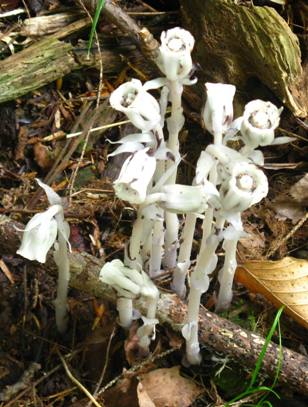Excerpts from Jim Conrad's
Naturalist Newsletter
From the October 19, 2003 Newsletter, written near Natchez, Mississippi, USA
INDIAN PIPE
 PHOTO BY BEA LAPORTE IN ONTARIO
PHOTO BY BEA LAPORTE IN ONTARIOYou can see that this plant is entirely white, as if it were related to mushrooms. However, it contains not a molecule of chlorophyll. Though you have to compare flowers and fruits to believe it, Indian Pipe is a flowering plant closely related to dogwoods, azaleas and blueberries. Still, instead of using solar energy to photosynthesize its food from air and water, it takes its food from other plants.
At first botanists thought that Indian Pipes parasitize tree roots. When they could find no evidence that its roots penetrated other roots, they decided that the species lived chiefly on the decaying parts of other plants -- that it was a saprophyte. But that's proved to be untrue, too. Fact is, they're still not sure how Indian Pipes get their food!
The best bet now is that Indian Pipes are "epiparasites" -- parasitic plants that form a relationship with other parasites to obtain their nutrients. It's been observed that underground fungi connect the Indian Pipe with roots of other species by means of fungal filaments. Beyond that, the whole story isn't known. It's a mystery. In fact, a great deal about Indian Pipe is mysterious and wonderful.
The plant was used by American Indians in eye lotions and for colds and fevers, plus on the internet you can read such quotations as Alice Morse Earle's "It is the weirdest flower that grows, so palpably ghastly that we feel almost a cheerful satisfaction in the perfection of its performance and our own responsive thrill, just as we do in a good ghost story."